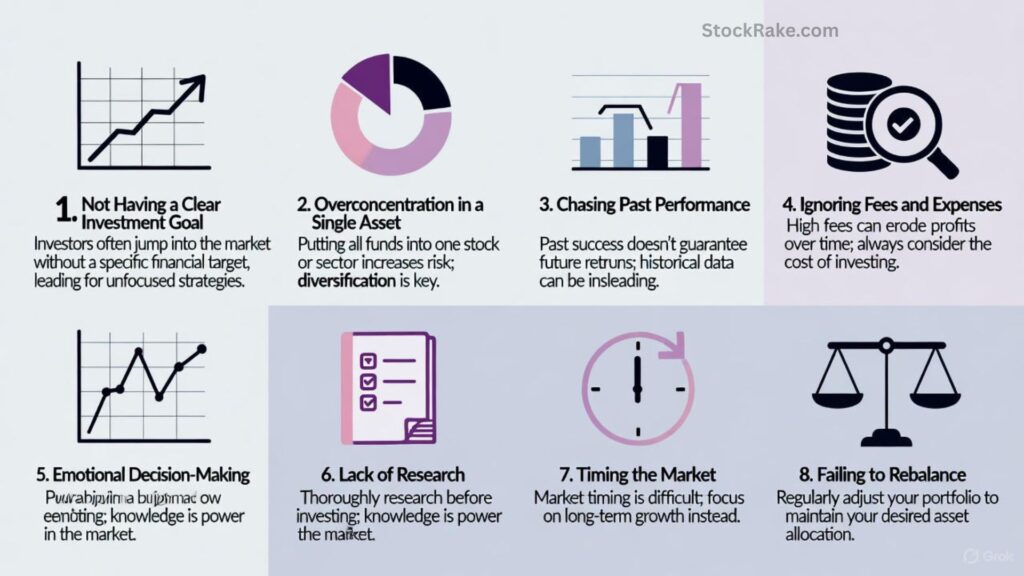Investing mistakes are something every Biggest new investor Make runs into — trust me, it happens to almost everyone. Investing can be amazing and even fun, but it’s also confusing, messy, and sometimes totally intimidating when you’re just starting out. One day crypto is mooning, the next day some “hot stock” tanks, and somehow everyone on the internet has a completely different opinion.
You’ve probably felt that pressure — there are books, blogs, TikTok “experts,” and that one uncle who swears his stock picks are the key to getting rich. Even with all this advice, new investors fall into the same traps over and over. And let’s be honest, even people who’ve been doing this for decades screw up sometimes.
Here’s the thing: investing isn’t about being perfect, and it’s not about buying at the exact right moment. Mostly, it’s about avoiding the dumb mistakes that cost you money — the ones beginners and even seasoned pros make all the time.
So, whether you’re buying your first ETF, dabbling in stocks, or planning for retirement, we’re going to break down the biggest investing mistakes, why they happen, and how you can avoid them — all in a way that doesn’t feel like a boring textbook.
🧩 1. Investing in Something You Don’t Understand
Warren Buffett says it best: “Never invest in a business you don’t understand.” Simple, right? But, oh boy, how often do people ignore this.

A lot of newbies get sucked into hype — crypto, penny stocks, “the next Tesla” — without actually knowing what the heck is going on. They see numbers go up and think “I gotta get in,” and then one small dip hits and panic sets in. It’s like being on a rollercoaster you didn’t even know you got on.
What to do instead
- Start broad. ETFs and mutual funds are basically baskets of stocks. So even if one company tanks, your whole portfolio isn’t in flames.
- If you want individual stocks, do some actual digging. How does the company make money? Who are its competitors? What could go wrong?
- And yes, read at least one annual report. I know, sounds boring, but it’s really just a 20–30 page snapshot of the company. You’ll know if it’s solid or shaky.
Example: Instead of buying random AI stocks because “AI is the future,” think about a tech ETF like Vanguard’s VGT. You get exposure to AI stuff, but you’re not betting your life savings on one random company.

Also Read: What Is the 50/30/20 Rule and Does It Still Work?
❤️ 2. Getting Too Attached to a Company
This is a big one. You like a company, maybe you’ve used its products forever, and now you’re thinking, “This is mine. I’m riding it to the moon.” But guess what? Stocks aren’t personal. You’re renting a piece of the company, not marrying it.
Signs you’re too attached
- Ignoring bad financial reports because “it’ll bounce back.”
- Holding on because you just love the brand.
- Doubling down after losses instead of, you know, thinking logically.
Pro tip
Set rules before you buy. Like, “If earnings drop two quarters in a row, I sell,” or “If debt doubles, I sell.” That way, you’re not making a decision when you’re panicking at 2 a.m. because your portfolio looks like a rollercoaster.

Also Read: How Are Global Events Impacting U.S. Markets Right Now?
⏳ 3. Being Impatient
Investing takes time. It’s a marathon, not a sprint — even though social media makes it look like everyone is hitting six figures overnight. Spoiler: most of them aren’t.

Here’s some numbers to get perspective:
- $10,000 invested at 8% per year becomes $21,589 in 10 years.
- $46,610 in 20 years.
- $100,627 in 30 years.
See that? Time does most of the heavy lifting. You don’t need to freak out over a bad week or month.
Tip:
Set long-term goals and review yearly, not daily. If you check every day, you’ll stress and probably make stupid moves. Trust me on this one.
🔁 4. Buying and Selling Too Often
Trading can feel exciting — it’s like a game — but overdoing it is a classic beginner mistake. Every trade comes with costs:

- Transaction fees, even tiny ones, add up.
- Short-term capital gains taxes can bite.
- And if you sell right before the market rebounds? Well… you missed it.
Some of the best-performing accounts are literally the ones the owners forgot existed. True story.
Better approach
- Hold quality investments for at least 3–5 years.
- Review occasionally, but only rebalance if your portfolio is way off your target allocation.
Less is often more when it comes to trading.
🕰️ 5. Trying to Time the Market
Everyone wants to buy low and sell high. Sounds amazing, right? Except almost nobody does it consistently — even professionals.
Dalbar did a study and found that average investors underperform because they jump in and out at the wrong times. Missing just the 10 best market days over 20 years can cut your returns in half. Half. Brutal.
Instead
- Focus on asset allocation — basically, how you spread your money across stocks, bonds, cash, etc. This actually explains 90% of your returns, more than timing the market.
- Use dollar-cost averaging (DCA) — invest the same amount every month. Market’s up, market’s down, doesn’t matter. You’re consistent.

Also Read: What Is Options Trading and How Risky Is It?
💸 6. Waiting to Break Even
Here’s a mental trap: the sunk cost fallacy. You bought a stock at $50, now it’s $35, and you think, “It has to go back up.” Problem is, the market doesn’t care what you paid.

Ask yourself:
“If I didn’t already own this stock, would I buy it today?”
If the answer is no… well, maybe it’s time to sell. Don’t tie up money in losers just because of pride or hope. Reinvest somewhere it can actually grow.
📊 7. Not Diversifying
All your eggs in one basket? Risky. Even if it’s a “great” stock. One bad day can ruin everything. Diversification spreads your risk across sectors, asset types, and even countries.

How to do it right
- Mix stocks, bonds, and cash equivalents.
- Spread across sectors — tech, healthcare, consumer goods, etc.
- Add some international exposure.
Rule of thumb: No more than 5–10% of your portfolio in a single investment.
😨 8. Letting Emotions Take Over
Fear and greed are like the two devils on an investor’s shoulder.
- Market drops → panic sell.
- Market surges → FOMO buy.
This is where most people lose more than the market itself would ever take from them.
How to handle it
- Write a plan: goals, timeline, risk tolerance.
- Automate investments. Out of sight, out of mind.
- Stop checking the news constantly. Headlines are made to freak you out.
As Buffett says: “Be fearful when others are greedy, and greedy when others are fearful.” Classic, but solid advice.
🧠 How to Avoid These Common Investing Mistakes

✅ Make a Clear Investment Plan
Write down your goals, your timeline, and your risk tolerance. Think of it as your emotional seatbelt when markets get messy.
✅ Automate
Set up monthly transfers. Review a couple times a year. Let compounding do its thing.
✅ Set Aside Fun Money
Want to speculate on crypto or startups? Fine, but only a tiny chunk — like 5% — and treat it like a hobby. Not your retirement plan.
✅ Know When to Walk Away
If a bet goes south, accept it and move on. Don’t let pride ruin your long-term strategy.

Also Read: What Is the 50/30/20 Rule and Does It Still Work?
⚡ Quick Recap: Top Mistakes New Investors Make
| Mistake | Why it’s bad | How to fix |
|---|---|---|
| Investing in stuff you don’t understand | Bad decisions | Stick to ETFs, sectors you get |
| Getting attached | Emotions cloud judgment | Set exit rules |
| Impatience | Miss long-term growth | Think in decades, not weeks |
| Overtrading | Eats profits | Buy-and-hold |
| Timing the market | Almost impossible | Dollar-cost averaging |
| Waiting to break even | Traps money | Reassess, don’t cling |
| Not diversifying | Risky | Spread across asset types |
| Emotions | Panic moves | Follow plan + automate |
🌱 New to Investing? Start Simple
Beginner-friendly stuff:
- Index funds / ETFs
- High-yield savings accounts
- Treasury bonds
- 401(k) / IRA accounts
- CDs or money market funds
Learn how markets behave without gambling your life savings.
🧭 Final Thoughts
Investing doesn’t need to be complicated. Mistakes happen. Pros make them. But if you understand the traps and control your emotions, you’re already ahead. Small, consistent steps beat impulsive moves every time.
It’s not about timing the market — it’s about time in the market.
💬 FAQs: Common Investing Questions for Beginners
Q1. How much should I start investing with?
Even $50–100/month works. Consistency > amount.
Q2. Should I hire a financial advisor?
If overwhelmed, yes. A fiduciary advisor can help.
Q3. What’s the safest investment for beginners?
Index funds or ETFs tracking broad markets.
Q4. How often should I check my investments?
Every few months is enough. Daily is stressful.
Q5. Can I lose all my money investing?
Not if you diversify and avoid high-risk bets.


